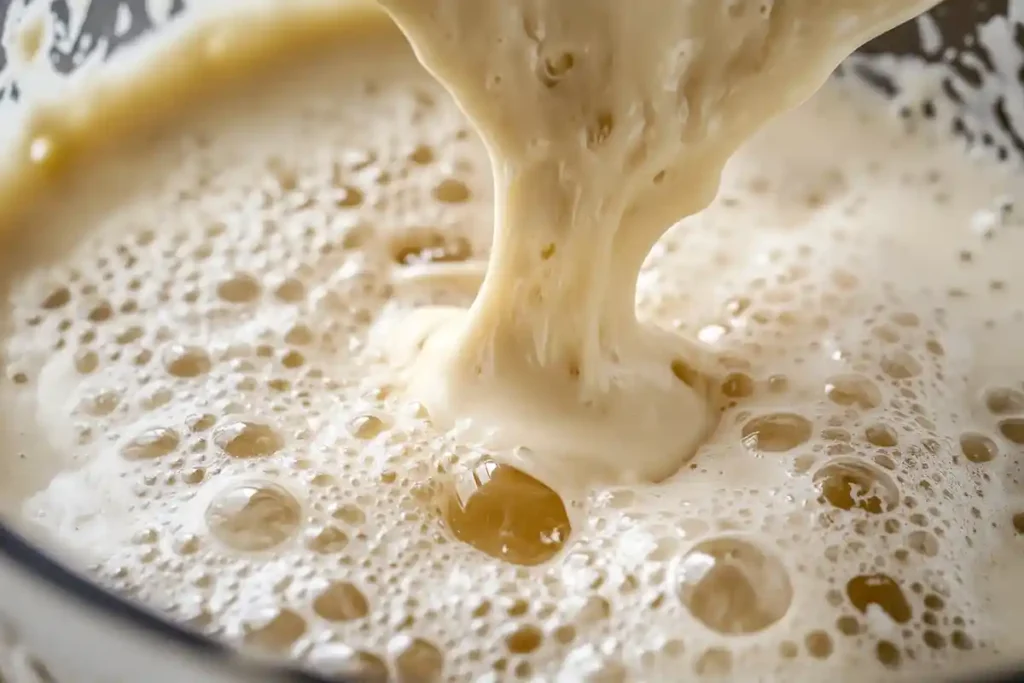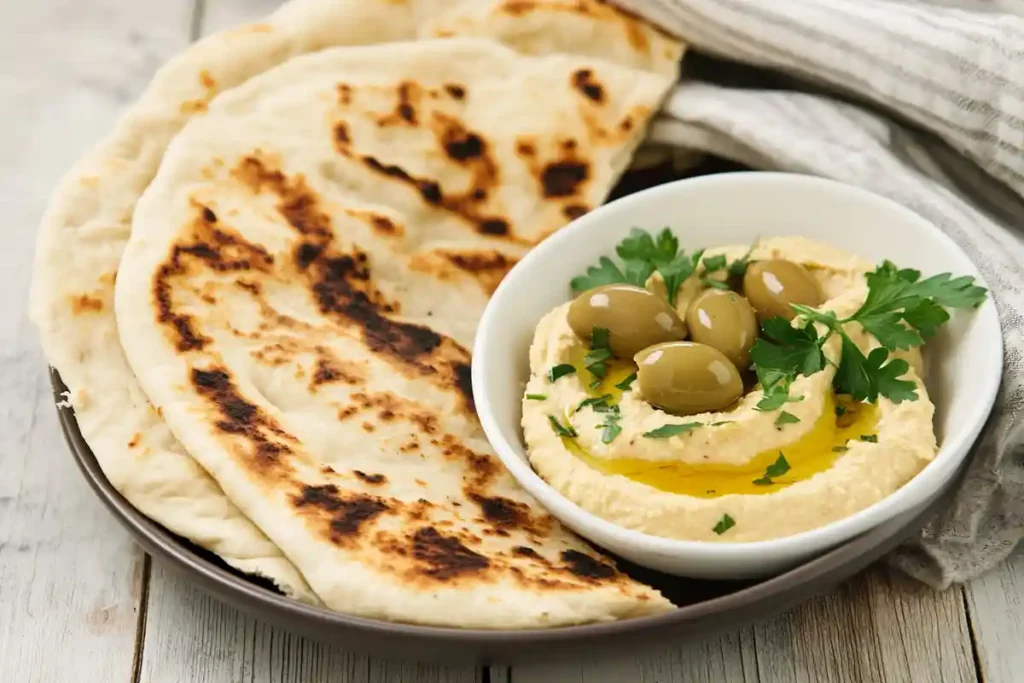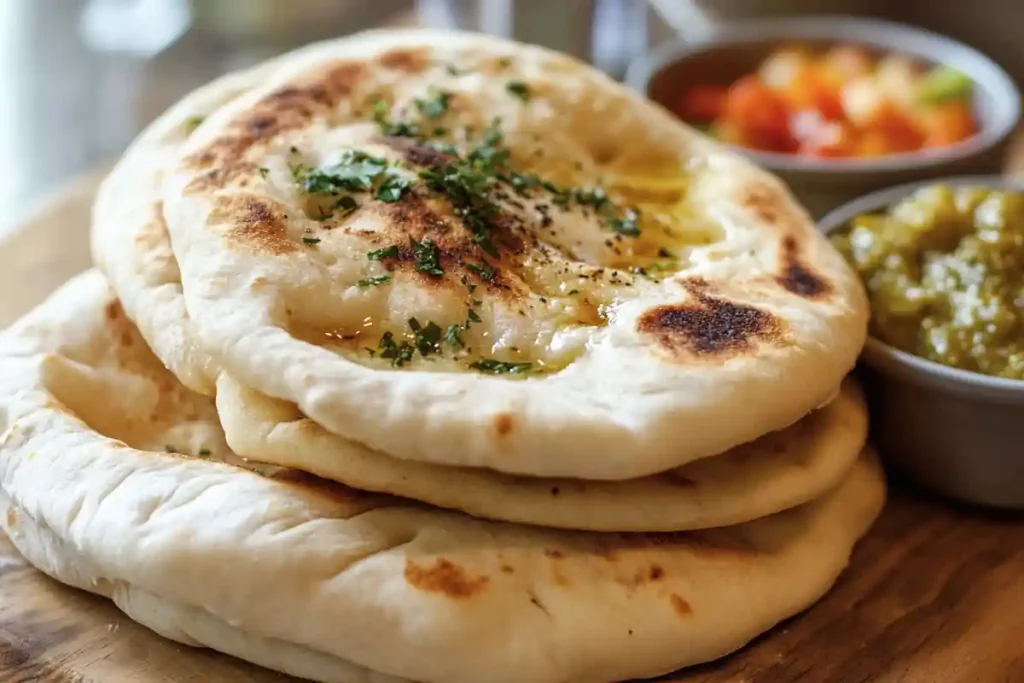Flatbreads have been a beloved staple across many cultures for centuries. But when combined with sourdough discard, they transform into something extraordinary—flavorful, tangy, and delightfully soft. If you’re someone who regularly bakes sourdough bread, chances are you’ve faced the dilemma of what to do with all that leftover discard. Instead of throwing it away, why not turn it into a delicious flatbread? In this article, we’ll take you through every step, from understanding sourdough discard to exploring its nutritional benefits, frequently asked questions and even a foolproof flatbread recipe. So, roll up your sleeves and let’s dive into the tangy world of sourdough discard flatbread!
Table of Contents
Introduction to Sourdough Discard Flatbread
Definition and Origin of Sourdough Discard Flatbread
Sourdough discard flatbread is a thin, unleavened bread made using the leftover starter from the sourdough fermentation process. Traditionally, flatbreads have existed in various forms around the globe—think naan, pita, or tortillas. However, incorporating sourdough discard gives this humble bread a tangy twist and prevents unnecessary waste.
Historically, sourdough starters have been cherished for their natural yeast and bacterial cultures. While traditional flatbreads rely on commercial yeast or baking powder, sourdough discard adds depth of flavor and a unique texture that sets it apart. It’s the perfect blend of tradition and innovation, all while being an eco-friendly kitchen practice.
Explore More Flatbread Delights: Discover the rich flavors of naan, the versatility of tortillas, and the softness of pita. Each has a unique story and taste waiting for you!
Importance of Utilizing Sourdough Discard in Recipes
Waste not, want not—that’s the golden rule in any kitchen. Using sourdough discard isn’t just about reducing waste; it’s about maximizing flavor and nutrition. Every time you refresh your sourdough starter, you’re left with a portion of discard. And while it might seem like excess, it’s a powerhouse ingredient waiting to shine.
Flatbreads made from sourdough discard are not only easy to prepare but also highly versatile. Whether served as a pizza base, a wrap, or a simple side for soups and stews, these flatbreads are all-around. Moreover, using discard minimizes your carbon footprint and contributes to sustainable cooking—a win-win for your taste buds and the environment!
Overview of the Article’s Content
In the sections that follow, we’ll break down everything you need to know about sourdough discard flatbread. First, we’ll demystify what sourdough discard is and explore its nutritional profile. Then, we’ll dive into it and address some common misconceptions. Of course, no guide is complete without tackling frequently asked questions, and we’ll wrap things up with key takeaways to ensure you’re fully equipped to bake your first batch of delicious flatbread.
Ready to turn that discard into gold? Let’s move on to understanding sourdough discard in more detail!
Understanding Sourdough Discard
What is Sourdough Discard?

Sourdough discard refers to the portion of sourdough starter that is removed before being fed with fresh flour and water. This process keeps the starter balanced and prevents it from becoming overly acidic or overflowing. But don’t be fooled by the term “discard”—it’s not waste. In fact, it’s a flavorful, fermented mixture brimming with wild yeast and beneficial bacteria.
Unlike an active starter, sourdough discard is not typically strong enough to make bread rise on its own. However, it still holds immense culinary potential. Its tangy flavor and slightly sour aroma make it a perfect addition to recipes like pancakes, crackers, and, of course, sourdough discard flatbread.
The best part? You’re gifted with this versatile ingredient every time you refresh your starter. Instead of tossing it, why embrace its potential and let it shine in your kitchen?
Nutritional Profile of Sourdough Discard
Though it might seem like a simple byproduct, sourdough discard carries a surprising nutritional punch. Since it’s made from flour and water that has undergone fermentation, it’s easier to digest than standard unfermented flour.
- Rich in Probiotics: Beneficial bacteria from fermentation support gut health.
- Lower Glycemic Index: Fermented flour may cause a slower rise in blood sugar levels.
- Nutrient Bioavailability: Fermentation reduces phytic acid, making nutrients like iron, magnesium, and zinc more accessible to your body.
Additionally, the discard retains trace amounts of protein and fiber from the flour, giving your flatbread a more complex nutritional profile than regular unleavened bread.
Health Benefits Associated with Sourdough Discard
Using sourdough discard in recipes isn’t just about flavor—it’s also about health. The fermentation process that creates the discard offers a range of health benefits that set it apart from regular flour-based doughs.
- Improved Digestion: The natural bacteria in discard help break down gluten, making it easier on the stomach.
- Supports Gut Health: Probiotics play a crucial role in maintaining a balanced gut microbiome.
- Reduced Phytic Acid: This makes minerals in the flour more bioavailable to your body.
Moreover, sourdough discard flatbread can be an excellent choice for those who experience bloating or discomfort from regular bread. While it’s not gluten-free, the fermentation process does make it gentler on digestion.
So, whether you’re aiming for sustainability, better nutrition, or just a tangy twist on your flatbread, sourdough discard deserves a prime spot in your kitchen arsenal.
Health Aspects of Sourdough Discard Flatbread
Nutritional Benefits of Sourdough Discard Flatbread
When it comes to sourdough discard flatbread, the nutritional benefits go far beyond its delicious taste and versatile uses. Thanks to the fermentation process, this flatbread isn’t just food—it’s functional food.
First, the naturally occurring probiotics in sourdough discard help support a healthy gut microbiome. These friendly bacteria improve digestion and can even boost immunity. Additionally, the fermentation process reduces phytic acid, a compound that binds minerals like iron, zinc, and calcium. As a result, these essential nutrients become more bioavailable to your body.
Moreover, sourdough discard flatbread tends to have a lower glycemic index compared to regular flatbreads. It means it causes slower spikes in blood sugar levels, making it a better option for those managing diabetes or trying to maintain balanced energy levels.
Not to mention, depending on the type of flour used in the discard, it’s often richer in fiber and protein than flatbreads made from commercial yeast. In short, every bite of sourdough discarded flatbread is packed with flavor and health-boosting properties.
Comparison with Other Flatbreads


So, how does sourdough discard flatbread stack up against other popular flatbreads like naan, pita, or tortillas? Let’s break it down:
| Flatbread Type | Leavening Agent | Flavor Profile | Health Benefits |
| Naan | Commercial yeast | Soft, slightly sweet | Moderate protein, lower fiber |
| Pita | Commercial yeast | Mild, slightly chewy | Balanced nutrition |
| Tortilla | Baking powder | Neutral, soft | Lower in protein and fiber |
| Sourdough Discard Flatbread | Wild yeast (discard) | Tangy, rich flavor | Higher probiotics, improved digestion, better nutrient absorption |
As seen in the table, sourdough discard flatbread outshines its counterparts in terms of digestion, probiotics, and overall nutritional value. Plus, the natural fermentation process gives it a depth of flavor that’s hard to match.
Addressing Common Health Concerns
Despite its many benefits, some people still have questions about the healthiness of sourdough discard flatbread. Let’s address a few common concerns:
- Is it high in gluten? Yes, sourdough discard flatbread contains gluten because it’s made from flour. However, the fermentation process partially breaks down gluten, making it easier to digest.
- Is it suitable for people with gluten intolerance? While it’s gentler on digestion, it’s not gluten-free and isn’t ideal for those with celiac disease.
- Does it contain sugar? Most flatbread recipes don’t require added sugar, but if sugar is included, it’s usually in small amounts.
Why Choose Sourdough Discard Flatbread for a Healthier Diet?
Ultimately, sourdough discard flatbread is more than just a way to reduce food waste—it’s an opportunity to make healthier dietary choices. From better digestion and nutrient absorption to a unique tangy flavour, this flatbread checks all the boxes.
Incorporating sourdough discard flatbread into your diet is not only a treat for your taste buds but also a step toward mindful, health-conscious eating.
Frequently Asked Questions About Sourdough Discard and Flatbread
Can you bake sourdough discard?
Absolutely! Sourdough discard is not only bakeable but also incredibly versatile. While it lacks the strength to make traditional sourdough bread rise on its own, it works wonderfully in recipes that don’t require significant leavening—like sourdough discard flatbread, pancakes, waffles, crackers, and even muffins.
When baking with discard, it’s essential to understand its characteristics. Discard has a tangy flavor and a slightly acidic profile, which adds depth to baked goods. For flatbread, this tanginess complements savory toppings or fillings beautifully.
So yes, instead of tossing your discard, use it in recipes that highlight its unique taste and texture. Waste not—bake more!
What uses a lot of sourdough discard?
If your starter is incredibly active and you’re generating a lot of discard, don’t worry—there are plenty of recipes that use significant amounts of it. Here are some ideas:
- Sourdough Discard Flatbread: Quick, easy, and uses a generous amount of discard.
- Pancakes and Waffles: Perfect for weekend brunches.
- Crackers: Crispy and flavorful snacks.
- Quick Bread and Muffins: Banana bread or savory muffins absorb discard beautifully.
- Pizza Crust: The tangy flavor shines when paired with classic pizza toppings.
The best part? These recipes are not only waste-free but also incredibly delicious.
Are sourdough flatbreads healthy?
Yes, sourdough flatbreads are considered healthier than many other types of flatbreads. Thanks to the fermentation process involved in making sourdough starter (and by extension, the discard), these flatbreads offer several health advantages:
- Easier Digestion: The fermentation process breaks down gluten and phytic acid, making the nutrients more accessible.
- Lower Glycemic Index: Sourdough flatbreads cause slower spikes in blood sugar.
- Rich in Probiotics: Beneficial bacteria support gut health.
That said, the healthiness of sourdough flatbread also depends on the ingredients you pair it with. For the best results, opt for whole-grain flour and avoid excessive oils or unhealthy toppings.
Is sourdough discard still healthy?
Yes, sourdough discard retains many of the health benefits of an active sourdough starter. While it may not be “alive” in the same way as an active, bubbly starter, it still contains residual probiotics, beneficial acids, and partially broken-down gluten.
Here’s why it’s still considered healthy:
- Probiotic Residue: Even dormant bacteria can support gut health.
- Nutrient Accessibility: Fermentation makes nutrients more bioavailable.
- Lower Acidity: Cooking or baking neutralizes excess acidity, making it easier on your stomach.
However, if your discard smells rancid, has mold, or shows any signs of spoilage, it’s time to discard it. Healthy discards should smell tangy, slightly sour, and pleasantly yeasty.
Quick Tips for Storing and Using Sourdough Discard
- Refrigerate It: Store discard in a sealed container in the fridge for up to a week.
- Freeze It: For long-term storage, freeze portions of discard for later use.
- Use It Regularly: The more frequently you incorporate discard into recipes, the less you’ll waste.
Conclusion
Recap of Key Points
Throughout this guide, we’ve uncovered the magic of sourdough discard flatbread—a simple yet flavorful creation that turns what might have been waste into a culinary treasure. We began by understanding what sourdough discard is and why it holds so much potential. From its tangy flavor to its gut-friendly probiotics, sourdough discard is far from mere kitchen waste.
We also explored the health benefits of sourdough discard flatbread, including its easier digestibility, lower glycemic index, and rich nutrient profile. Compared to other flatbreads, it stands out not only for its unique taste but also for its health advantages.
Furthermore, we addressed common concerns and questions about sourdough discard—yes, you can bake with it, yes, it’s healthy, and yes, it’s incredibly versatile. Whether you’re making flatbread, pancakes, or even crackers, there’s no reason to let your discard go to waste.
Encouragement to Try Making Sourdough Discard Flatbread
If you’ve ever hesitated to use your sourdough discard, let this be your sign to give it a try. Sourdough discard flatbread is not just about saving leftovers—it’s about embracing a sustainable, creative, and delicious way of cooking. The recipe is forgiving, the process is straightforward, and so is the result: a soft, tangy flatbread that’s perfect for wrapping, dipping, or serving alongside your favorite dishes.
Whether you’re a seasoned sourdough baker or just starting your fermentation journey, flatbread is a fantastic way to make the most of your discard.
Final Thoughts on Incorporating Sourdough Discard into Cooking
In the grand scheme of baking and sustainability, sourdough discard flatbread represents a beautiful balance between flavor and responsibility. It’s more than just bread—it’s a statement about mindful cooking, waste reduction, and appreciating the humble yet powerful sourdough starter.
So, the next time you refresh your starter, pause before tossing that discard. Instead, heat your skillet, roll out some dough, and savor every bite of your homemade sourdough discard flatbread.
Happy baking, and may your kitchen always smell of warm, tangy bread!

